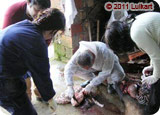Cross-species Transmission of Infectious Disease: A Population Genomic Approach Tracking Brucellosis in Wildlife, Livestock, and Humans
Summary:

Brucellosis is a highly infectious disease, caused by an intra-cellular bacterium (Brucella spp), that has serious implications for human and animal health. Brucellosis is perhaps the most common bacterial zoonotic disease worldwide, and is responsible for enormous economic losses. For example, control of a single local brucellosis outbreak in 2003 in Britain cost 700,000 Euros. Around the Greater Yellowstone Ecosystem in the USA, three states (Idaho, Montana, and Wyoming) recently lost their 'brucellosis free' status, costing livestock growers and wildlife agencies millions of dollars for new disease testing requirements and research to limit brucellosis.
In Portugal, brucellosis represents a major public health concern – in September 2005, forty people contracted it. In July 2006, many people contracted brucellosis in an illegal slaughter house for livestock near Porto, Portugal. Brucella was the first microbe developed for biowarfare (by Russia and the USA) and is still a possible weapon of bioterrorism and agricultural terrorism.
Unfortunately, the wildlife species and population of origin of most brucellosis outbreaks is unknown and difficult to determine. Wildlife (ungulates) play a key role as reservoir species and could make control or eradication very difficult for the Eurpoean Union, Portugal, and the USA. Wolves could potentially spread Brucella (e.g. to ungulates), but no one has rigorously tested for such transmission.
Southern Europe and especially Portugal are excellent geographic areas to study cross-species transmission of Brucella, because hundreds of Brucella isolates are available from different species (cattle, sheep, goats, humans, and wildlife) from each of several different outbreaks. The simultaneous study of two replicate systems (Europe and USA) should greatly improve our understanding of genetic mechanisms and ecological factors influencing transmission of Brucella within and among species.
Collaborators:
Claudia Almendra, Albano Beja-Pereira, Betsy Bricker, Paul Cross, Ryan Clark, Beth Harris, Inacia Sa, Rick Wallen, P.J. White and others…
Publications:
- Almendra, C., T.L. Silva, A. Beja-Pereira, A.C. Ferreira, L.Ferrão-Beck, M. I. . Sá, B.J. Bricker, G. Luikart. 2008. "HOOF-Print" genotyping and haplotype inference discriminates among Brucella spp isolates. Infection, Genetics and Evolution. In press.
- Beja-Pereira, A., B. Bricker, S. Chen, P.J. White, and G. Luikart. DNA Suggests Recent Brucellosis Outbreaks near Yellowstone Park Originated from Elk. In press.
- Cross, P. et al.. Disease in the 'New West': effects of elk population increases on brucellosis dynamics. In press.
- Ferreira, A.C., C. Almendra, R. Cardoso, M.S. Pereira, A. Beja-Pereira, G. Luikart, and M.I.C. de Sá Development and evaluation of a selective medium for improved isolation of Brucella suis. In review.
- Luikart, G., K. Pilgrim, J. Visty, V.O. Ezenwa, and M.K. Schwartz. 2008. Candidate gene microsatellite variation is associated with parasitism in wild bighorn sheep. Biology Letters, 4:228-231.
